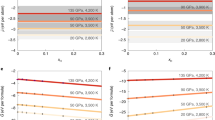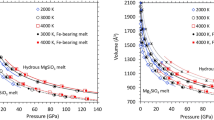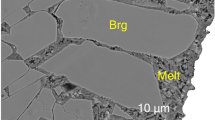Abstract
The absence of moonquakes originating deeper than about 1,100 km (ref. 1) implies that the lower mantle of the Moon could be partially molten. Up to 30% melt by volume has been estimated to exist between about 1,200 and 1,350 km depth2. However, the absence of recent volcanic activity at the Moon’s surface implies that such deep partial melts must be at least as dense as their surroundings. Here we use a combination of in situ synchrotron X-ray absorption techniques and molecular dynamics simulations to determine the density range of primitive lunar melts at pressures equivalent to those in the lunar interior. We find that only melts that contain about 16 wt% titanium dioxide are neutrally buoyant at depths corresponding to the top of the proposed partial melt zone. These titanium-rich melts are formed by deep partial melting of titanium-rich rocks. As such rocks are thought to have formed at shallow levels during crystallization of the lunar magma ocean, we infer that a significant vertical transport of mass occurred before melt formation. Our measurements therefore provide evidence for a large-scale overturn of the lunar mantle shortly after crystallization of the magma ocean and point to the continuing influence of a dense, titanium-rich reservoir on lunar interior evolution.
This is a preview of subscription content, access via your institution
Access options
Subscribe to this journal
Receive 12 print issues and online access
$259.00 per year
only $21.58 per issue
Buy this article
- Purchase on Springer Link
- Instant access to full article PDF
Prices may be subject to local taxes which are calculated during checkout



Similar content being viewed by others
References
Nakamura, Y. Farside deep moonquakes and the interior of the Moon. J. Geophys. Res. 110, E01001 (2005).
Weber, R. C., Lin, P. Y., Garnero, E. J., Williams, Q. & Lognonne, P. Seismic detection of the lunar core. Science 331, 309–312 (2011).
Sanloup, C., Guyot, F., Gillet, P., Fiquet, G., Mezouar, M. & Martinez, I. Density measurements of liquid Fe–S alloys at high-pressure. Geophys. Res. Lett. 27, 811–814 (2000).
Sanloup, C., van Westrenen, W., Dasgupta, R., Maynard-Casely, H. & Perrillat, J-P. Compressibility change in iron-rich melt and implications for core formation models. Earth Planet. Sci. Lett. 306, 118–122 (2011).
Elkins-Tanton, L. T., Chatterjee, N. & Grove, T. L. Magmatic processes that produced lunar fire fountains. Geophys. Res. Lett. 30, 1513 (2003).
Delano, J. W. Pristine lunar glasses—criteria, data, and implications. J. Geophys. Res. 91, D201–D213 (1986).
Wagner, T. P. & Grove, T. L. Experimental constraints on the origin of lunar high-Ti ultramafic glasses. Geochim. Cosmochim. Acta 61, 1315–1327 (1997).
Elkins-Tanton, L. T., Chatterjee, N. & Grove, T. L. Experimental and petrological constraints on lunar differentiation from the Apollo 15 green picritic glasses. Meteorit. Planet. Sci. 38, 515–527 (2003).
Guillot, B. & Sator, N. A computer simulation study of natural silicate melts. Part I: Low pressure properties. Geochim. Cosmochim. Acta 71, 1249–1265 (2007).
Guillot, B. & Sator, N. A computer simulation study of natural silicate melts. Part II: High pressure properties. Geochim. Cosmochim. Acta 71, 4538–4556 (2007).
Krawczynski, M. J. & Grove, T. L. Experimental investigations of fO2 effects on Apollo 17 orange glass phase equilibria. Lunar Planet. Sci. Conf. 39, 1231 (2008).
Lange, R. A. A revised model for the density and thermal expansivity of K2O–Na2O–CaO–MgO–Al2O3–SiO2 liquids from 700 to 1,900 K: extension to crustal magmatic temperatures. Contrib. Mineral. Petrol. 130, 1–11 (1997).
Ghiorso, M. S. & Kress, V. C. An equation of state for silicate melts. II calibration of volumetric properties at 105 Pa. Am. J. Sci. 304, 679–751 (2004).
Delano, J. W. Buoyancy-driven melt segregation in the Earth’s Moon 1. Numerical results. Proc. Lunar Planet. Sci. Conf. 20, 3–12 (1990).
Lange, R. A. & Carmichael, I. S. E. Density of Na2O–K2O–CaO–MgO–FeO–Fe2O3–Al2O3–TiO2–SiO2 liquids: New measurements and derived partial molar properties. Geochim. Cosmochim. Acta 51, 2931–2946 (1987).
Smith, J. R. & Agee, C. B. Compressibility of molten green glass and crystal-liquid density crossovers in low-Ti lunar magma. Geochim. Cosmochim. Acta 61, 2139–2145 (1997).
van Kan Parker, M., Agee, C. B., Duncan, M. S. & van Westrenen, W. Compressibility of molten intermediate-high Ti lunar glass and implications for density cross-overs in the lunar mantle. Geochim. Cosmochim. Acta 75, 1161–1172 (2011).
Circone, S. & Agee, C. B. Compressibility of molten high-Ti mare glass: Evidence for crystal-liquid density inversions in the lunar mantle. Geochim. Cosmochim. Acta 60, 2709–2720 (1996).
Sakamaki, T. et al. Density of high-Ti basalt magma at high pressure and origin of heterogeneities in the lunar mantle. Earth Planet. Sci. Lett. 299, 293–297 (2010).
Garcia, R. F., Gagnepain-Beyneix, J., Chevrot, S. & Lognonné, P. Very preliminary reference Moon model. Phys. Earth Planet. Inter. 188, 96–113 (2011).
Khan, A., Maclennan, J., Taylor, S. R. & Connolly, J. A. D. Are the Earth and the Moon compositionally alike? Inferences on lunar composition and implications for lunar origin and evolution from geophysical modelling. J. Geophys. Res. 111, E05005 (2006).
Hauri, E. H., Weinreich, T., Saal, A. E., Rutherford, M. C. & Van Orman, J. A. High pre-eruptive water contents preserved in lunar melt inclusions. Science 333, 213–215 (2011).
Snyder, G. A., Taylor, L. A. & Neal, C. R. A chemical model for generating the sources of mare basalts—combined equilibrium and fractional crystallization of the lunar magmasphere. Geochim. Cosmochim. Acta 56, 3809–3823 (1992).
Hess, P. C. & Parmentier, E. M. A model for the thermal and chemical evolution of the Moons interior—implications for the onset of mare volcanism. Earth Planet. Sci. Lett. 134, 501–514 (1995).
de Vries, J., van den Berg, A. & van Westrenen, W. Formation and evolution of a lunar core from ilmenite-rich magma ocean cumulates. Earth Planet. Sci. Lett. 292, 139–147 (2010).
Beck, A. R. & Hess, P. C. Ilmenite solubility in lunar basalts as a function of temperature and pressure: Implications for petrogenesis. Lunar Planet. Sci. Conf. 35, 1807 (2004).
Wyatt, B. The melting and crystallisation behaviour of a natural clinopyroxene–ilmenite intergrowth. Contrib. Mineral. Petrol. 61, 1–9 (1977).
van Kan Parker, M. Physical and Chemical Properties of Lunar Magma PhD thesis, VU Univ. Amsterdam (2011).
de Vries, J., van den Berg, A. P. & van Westrenen, W. Numerical convection modelling of a compositionally stratified lunar mantle. Lunar Planet. Sci. Conf. 42, 1745 (2011).
van Kan Parker, M. et al. Calibration of a diamond capsule cell assembly for in situ determination of liquid properties in the Paris–Edinburgh press. High Press. Res. 30, 332–341 (2010).
Acknowledgements
This work was financially supported by a European Young Investigators award and Netherlands Space Office User Support Programme Space Research grant to W.v.W., and a European Research Council starting grant (FP7 grant agreement no. 259649) to C.S. We acknowledge the European Synchrotron Radiation Facility for provision of synchrotron radiation facilities and thank D. R. Neuville for carrying out 1-bar density measurements.
Author information
Authors and Affiliations
Contributions
W.v.W., C.S. and M.v.K.P. devised the project. All authors participated in data acquisition. M.v.k.P., C.S., E.J.T., J-P.P., M.M., N.R. and W.v.W. carried out the in situ experiments. N.S. and B.G. carried out the computer simulations. W.v.W., M.v.K.P. and C.S. wrote the paper with input from all co-authors.
Corresponding author
Ethics declarations
Competing interests
The authors declare no competing financial interests.
Supplementary information
Supplementary Information
Supplementary Information (PDF 674 kb)
Rights and permissions
About this article
Cite this article
van Kan Parker, M., Sanloup, C., Sator, N. et al. Neutral buoyancy of titanium-rich melts in the deep lunar interior. Nature Geosci 5, 186–189 (2012). https://doi.org/10.1038/ngeo1402
Received:
Accepted:
Published:
Issue Date:
DOI: https://doi.org/10.1038/ngeo1402
This article is cited by
-
Titanium-rich basaltic melts on the Moon modulated by reactive flow processes
Nature Geoscience (2024)
-
The lunar solid inner core and the mantle overturn
Nature (2023)
-
A record of post-accretion asteroid surface mixing preserved in the Aguas Zarcas meteorite
Nature Astronomy (2022)
-
Interiors of Earth-Like Planets and Satellites of the Solar System
Surveys in Geophysics (2022)
-
Theoretical models and experimental determination methods for equations of state of silicate melts: A review
Science China Earth Sciences (2019)



